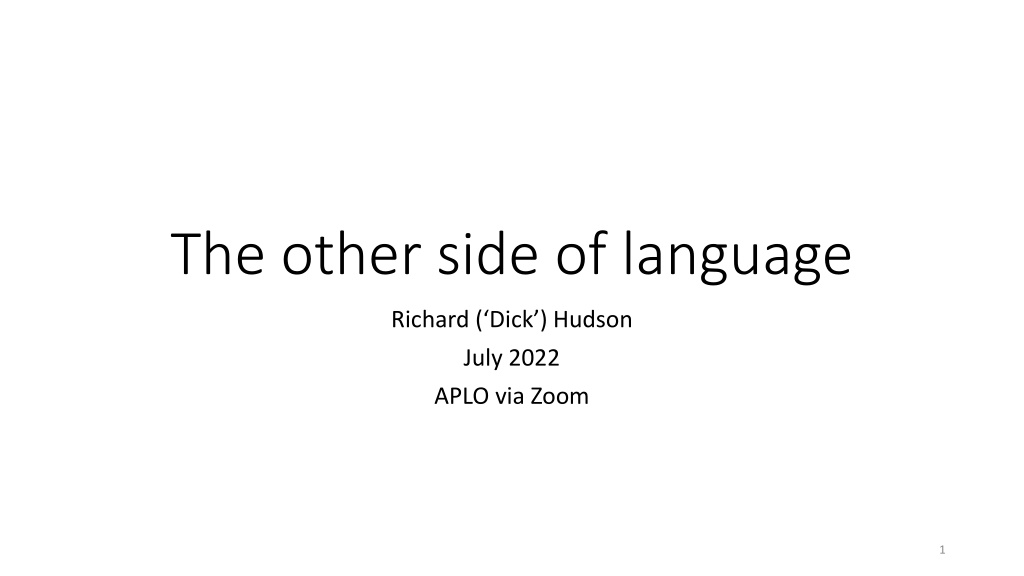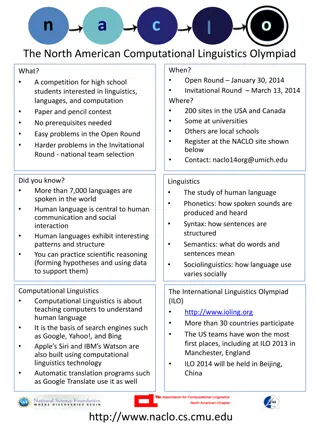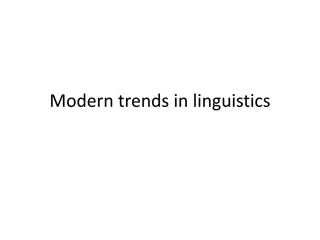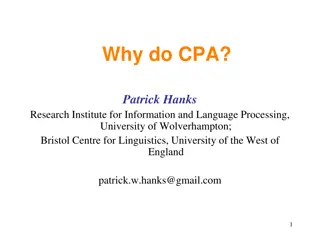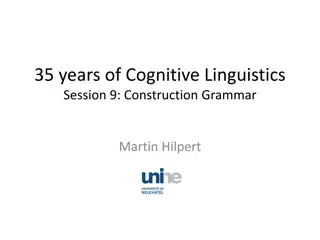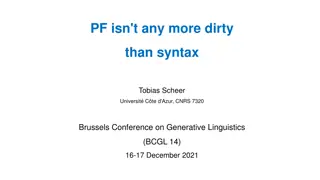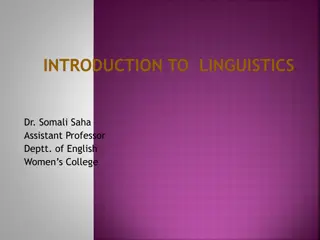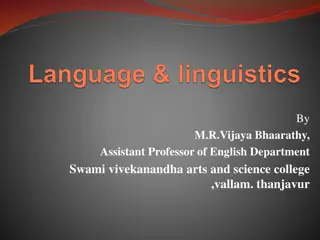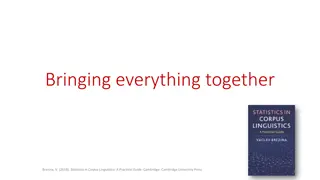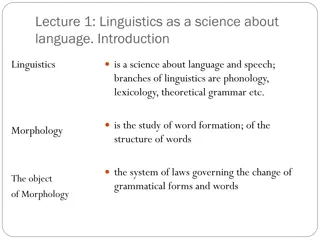Exploring Linguistics and the Linguistics Olympiad
Dive into the world of linguistics with retired Professor Dick Hudson as he shares his journey of discovery and passion for language. Explore the challenges and joys of the Linguistics Olympiad, bridging the gap between the hard and soft sides of language. Discover the intricate connections in languages, the fun of linguistic puzzles, and the satisfaction of understanding language at a deeper level.
Download Presentation

Please find below an Image/Link to download the presentation.
The content on the website is provided AS IS for your information and personal use only. It may not be sold, licensed, or shared on other websites without obtaining consent from the author. Download presentation by click this link. If you encounter any issues during the download, it is possible that the publisher has removed the file from their server.
E N D
Presentation Transcript
The other side of language Richard ( Dick ) Hudson July 2022 APLO via Zoom 1
Self-introduction 2022: I m a retired Professor of Linguistics at UCL (London) And I m chair of the UK Linguistics Olympiad (UKLO) 2004: I retired at age 65, so I m now 82 1959: I discovered linguistics in my BA degree (French and German) in Cambridge 1950: I discovered grammar verbs, subjects, etc. = connections in sentences Etymology e.g. Dick < Rick < Rich < Richard = connections among words 2022: I still love connections 2
Plan 1. 2. 3. 4. 5. 6. 7. 8. 9. 10. What is furniture? 11. The LO and linguistics The Linguistics Olympiad (and linguistics) The two sides of language The other side of language The morphology of GO A mysterious gap in the BE paradigm Syntactic overload Semantic overload The house variable in Buckie, Scotland What is English? 3
1. The Linguistics Olympiad (and linguistics) The challenge: find connections which are Obvious (UKLO Breakthrough level for Year 5-6), e.g. Swedish Den Adj Noun+en r Adj Det Adj N+et r Adj+t La does not mean ate ! But wajdoes mean bread . And j-means I . Almost invisible (UKLO Advanced level), e.g. Tseltal 4
The fun of LO The challenge of a puzzle (like Sudoku, Wordle, etc) The excitement of discovery The satisfaction of understanding The excitement of competition The interest of a subject which is outside the normal curriculum. In the UK we have 4,000 competitors each year, All volunteers Most enjoy it. 5
Linguistics A university subject With departments, professors, conferences, textbooks, degree programmes Research Description how a language works History how a language has changed Sociolinguistics how a language varies with social structures Psycholinguistics how we speak and listen etc. Teaching About all these topics 6
2. LO and linguistics: the two sides of language The LO face: Clear, general Challenging Mathematical, like a crystal hard linguistics The other face Fuzzy, particular Easier but complex Human, like a cloud soft linguistics Linguistics includes both the hard and the soft sides. 7
Hard and soft linguistics Hard: English Normally SVO: I like that. Exceptionally, OSV: That I like. LO problems are hard Soft: When do we use OSV? Why? How has word order changed in English? How do children learn word order? 8
Hard linguistics: what LO teaches you Suppose you re very good at seeing patterns And you solve lots of LO problems What do you learn about language? Language is very complicated. Language is very organised. Languages can be extraordinarily different from each other. All these things are true, important and interesting. 9
3. The other side of language: soft linguistics Soft linguistics is missing from LO. But it s an important part of linguistics. Part of any university degree in linguistics. And it s the part that s most interesting to most people. But it s also the most complex. Main point: language is human Made by humans For humans 10
Language and humanity Made by humans A collective product For humans to learn With human brains On the basis of their social experience of language We try to be exactly the same as our in-group And for humans to use With human brains For human purposes Much more than communicating facts 11
Made by humans Bottom-up, through ever-changing usage, not top-down by prescription. Nobody is in control of language. A general principle of linguistics: Describe language as it actually is. (descriptive) Don t prescribe how it ought to be. (prescriptive) For example, let s see how ordinary speakers have shaped English. 12
4. The morphology of GO Consider the history of GO, UNDERGO, FOREGO and FORGO E.g. undergo an investigation = be investigated Forego only in foregone conclusion, foregoing remarks Think before Forgo a holiday = not have a holiday Think forget As revealed by Google N-grams Based on millions of books in many languages Reported as percentages of all words used in each year 13
The recent history of go, undergo, forego/forgo 14
The inflections of GO Went is a suppletive form 16
Suppletion Some irregular forms are more irregular than others WALK: regular (+ed) PUT: no change (+ed > 0) TAKE: took (ei > , +ed > 0) BUY: bought (ai > :, +ed > t) THINK: thought ( > :, nk > 0, +ed > t) GO: went (g > w n, +ed > t) - suppletion . Suppletion is socially dangerous because it s very noticeable! 17
The inflections of UNDERGO Why was undergone so common? Underwent is as healthy as went Why was undergoing so rare? 18
Underwent > undergoes, forewent < foregoes Very rare! 19
So what? Generally, past tense > s-form, but for FOREGO, FORGO the relation is reversed. Why? Because everybody is scared to be prominently different. So we all avoidforewent, and rephrase. E.g. I wondered whether to forgo the ice-cream, and in the end I did forgo it. So no-one knows what the correct past tense of FOREGO or FORGO is. Is it forewent Or foregoed? 20
Patterns and society The formal patterns are very clear: Go:went :: undergo:underwent :: forgo:forwent But we need social support for using the suppletive form. Formal patterns are not enough. 21
5. A mysterious gap in the BE paradigm Basic Contracted Inverted + not Contracted + not Contracted negated Contracted negated inverted I am I m Am I I am not I m not ????? Aren t I You are You re Are you You are not You re not You aren t Aren t you She is She s Is she She is not She s not She isn t Isn t she We are We re Are we We are not We re not We aren t Aren t we They are They re Are they They are not They re not They aren t Aren t they 22
Why no *amnt? Nobody really knows. But one possibility is that there s a logical clash between: I-form = am Negative = aren t This is an example of the Nixon diamond The American president was both a Republican and a Quaker As a Republican he could wage war. As a Quaker he could not wage war. 23
So what? Once again, formal patterns are not enough. The rules also have to be compatible with human logic. In this case, the logic is default inheritance: If A isa B And f(B) = C Then f(A) = C Unless f(A) already = D [i.e. unless f(A) is an exception] Human logic clearly has to accommodate exceptions Unlike classical logic. 24
6. Syntactic overload Which of these sentences make sense? 1. The doctor who supervised the intern who I knew met Jack. 2. The administrator who the intern who the nurse supervised lost the medical reports. 3. The patient who the nurse who the clinic had hired admitted met Jack. 4. The patient who the nurse who the clinic had hired met Jack. 25
Syntactic structures 1. The doctor who the intern who I knewworked for met Jack. 2. The administrator who the intern who the nurse supervised lost the medical reports. 3. The patient who the nurse who the clinic had hiredadmitted met Jack. 4. The patient who the nurse who the clinic had hired met Jack. 26
Confused? Arrows show syntactic relations ( dependencies ) The doctor who the intern who I knewworked for met Jack. 5 incomplete dependencies Brain overload!!! 5 relations for your working memory too many. 27
So what? Once again, formal patterns aren t enough. They also have to be compatible with the limited capacity of the human memory. These pressures have influenced the evolution of syntax. E.g. SOV is the most common order. But SVO is almost as common. This minimizes the number of simultaneous dependencies. Because both S and O depend on V And they can both be next to V. 28
7. Semantic overload This sentence was found in a manual for nurses: No head wound is too trivial to be ignored. Is it sensible? What about this sentence? No head wound is too trivial to be treated. They can t both be sensible! Too many negative words. 29
So what? Once again, formal patterning isn t enough. The words have to have meanings which we can integrate into a coherent message. Our minds have limited capacity. 30
8. The house variable in Buckie, Scotland House = [h us] (regional) or [hu:s] (local) E.g. Come [ u]t here I can blow bubbles [u:]tside! (Ellie, 3;5) It s r[u:]nd the wrong way no, turn it r[ u]nd (Ellie s mother, Gabbie) Both variants are used, so we can calculate their relative frequencies. 31
Children learn their mothers frequency % local [u:] Child mother Child = mother Oldest 3;6 Youngest 2;10 32
Children also learn their mothers lexical preferences = mother Children are *very* close to their mothers 33
So what? Social contrasts such as local loyalty are continuous variables. To indicate these contrasts we can use the statistics of spoken or written texts. With different degrees of loyalty to many different communities E.g. local , male , teenager , tough , educated , 34
9. What is English? Which of these are English? Entries maun be original and ne er afore prentit. Scots Long ol ples i gat rul / Ol manmeri i mas skul. Everywhere has rules / Everyone must go to school Tok Pisin (Papua New Guinea) Have not saints lips? Shakespeare (16th 17th century) t w s god cyning That was a good king. Beowulf (10th century?) 35
From Dutch to German Ik heb het gezien. (Dutch) Ich habe es gesehen. (German) Where is the border between Dutch and German? Problem: every pair of neighbouring villages along the Rhine understand each other! = a dialect continuum. Languages and dialects have no borders. 36
So what? Languages and dialects are like other conceptual categories. Categories don t exist in the world. We invent them, we don t discover them, so there s no true boundary Our main tool for categorization is language. We think in categories. But we don t know where their boundaries are, And mostly we don t care - Except in law and in science. 37
10. What is furniture? Table Chair Standard lamp TV Waste-paper basket Table lamp Ash tray Book 38
So what? Our mental categories are defined by prototypes typical examples. Not by their boundaries. I.e. there are no necessary and sufficient conditions for membership. Members may be clear (typical) or unclear (untypical). Beware of definitions, Because these try to create boundaries. Instead, ask for descriptions of typical examples. 39
11. The LO and linguistics The LO principle (on the IOL website) No prior knowledge of linguistics or languages is required: even the hardest problems require only your logical ability, patient work, and willingness to think around corners. There s some truth here: some of our star competitors have been mathematicians with no interest in languages or linguistics. But surely some knowledge of linguistics helps? If only to save time And even if it doesn t help, it s interesting! 40
Thank you! This talk may be downloaded from https://dickhudson.com/talks/ 41
